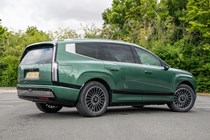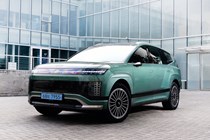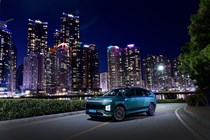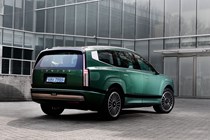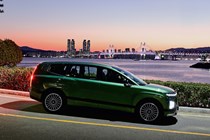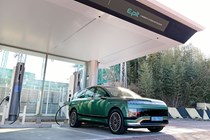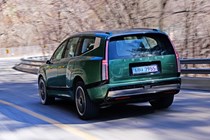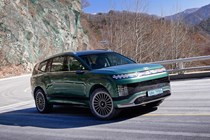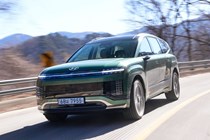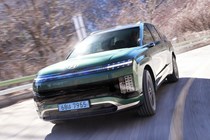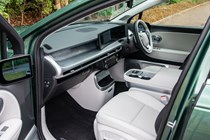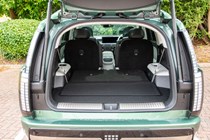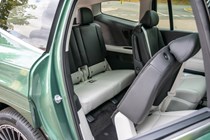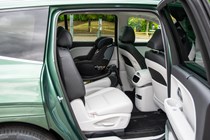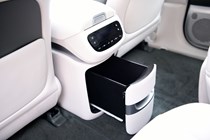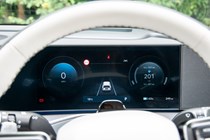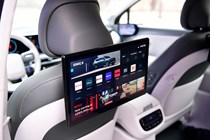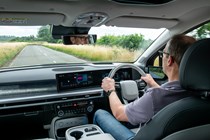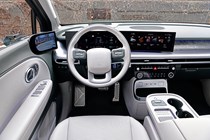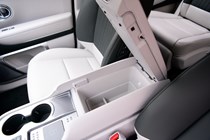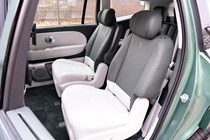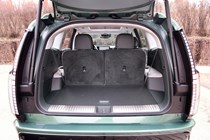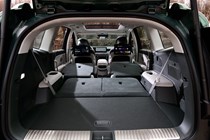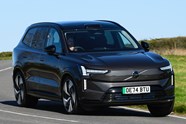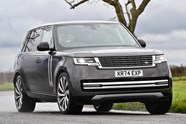
Hyundai Ioniq 9 review: Big and exceedingly clever
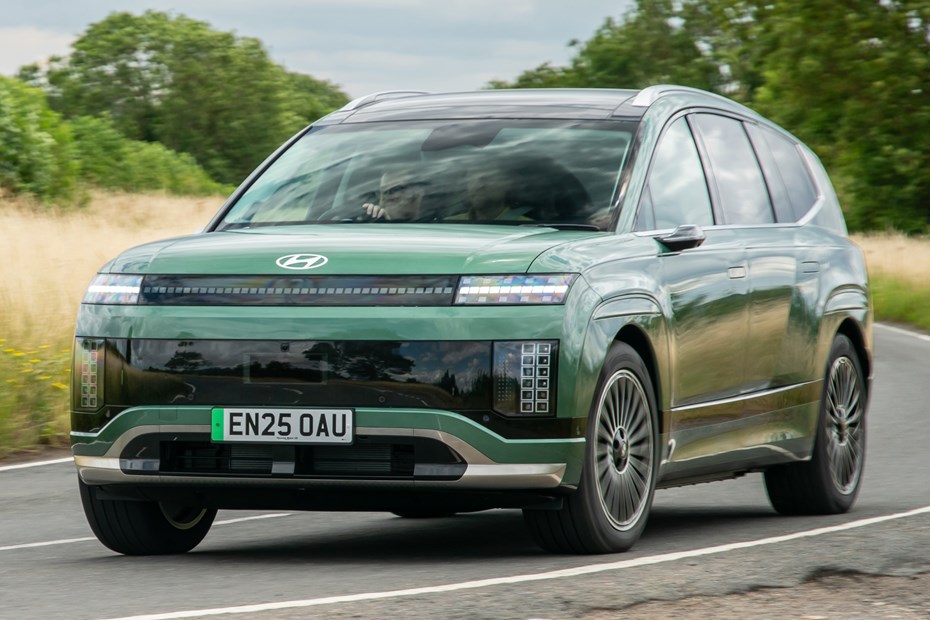
At a glance
| Price new | £64,995 - £78,595 |
|---|---|
| Used prices | £51,584 - £70,070 |
| Road tax cost | £195 - £620 |
| Insurance group | 42 - 49 |
Get an insurance quote with

|
|
| Fuel economy | 3 - 3.1 miles/kWh |
| Range | 372 - 385 miles |
| Miles per pound | 4.8 - 9.1 |
| Number of doors | 5 |
| View full specs for a specific version | |
Available fuel types
Fully electric
Pros & cons
- Hugely practical and flexible interior
- Smooth and sophisticated to drive
- Good range and super-fast charging
- Infotainment is quite fiddly
- Some cheap materials inside
- Lots of body roll in bends
Hyundai Ioniq 9 SUV rivals
Overview
Should you buy a Hyundai Ioniq 9?
The electric seven-seater Hyundai Ioniq 9 impressed us hugely in Korea, and feels just as home with right-hand drive in the UK. The Korean brand’s largest electric car is perhaps one of its best, offering a luxurious ambiance, lots of space and impressive seating flexibility. At over five metres long it’s a whopper and the looks will be divisive, but the Ioniq 9 is an SUV you should seriously consider buying if you’re in the market for something this size.
Why? Because it’ll end up being cheaper than the Volvo EX90 – a car that is less spacious, has a similar range and is less user friendly – and has a suppler ride than its closest sibling, the similarly priced Kia EV9. It even gives off the odd Range Rover vibe at what’ll be a significantly lower price.
What’s new?
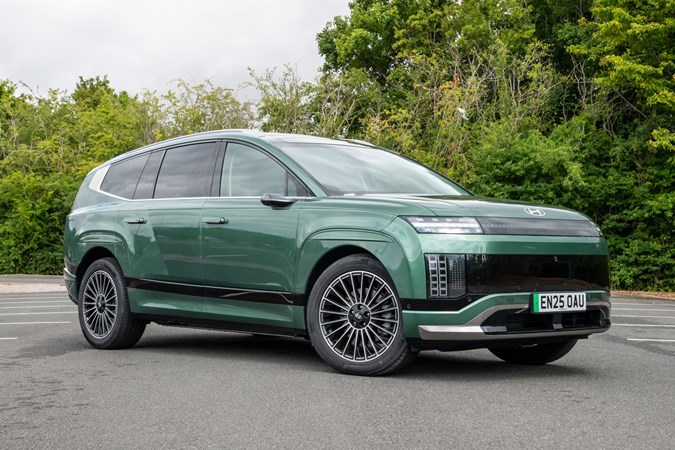
Underneath the Ioniq 9 are the same bones you’ll find under the smaller Ioniq 5 and rival Kia EV9, just a bit bigger. The battery pack has also grown in size to comfortably beyond even the EV9’s to provide a potential real world range in excess of 300 miles. Even so, a 10-80% rapid charge takes less than 25 minutes.
Hyundai is offering a range of different power options. Both rear- and all-wheel drive versions will be available, the latter in two power outputs, and even the most basic of trims includes a huge amount of standard equipment. You’ll need the top Calligraphy trim like our test car for the full luxury experience, though.
How does the rest of the Ioniq 9 stack up? We’ve driven one of the first right-hand drive examples in the UK to find out. If you’re wondering how we test cars, have a look at our explainer page.
What’s it like inside?
The interior of the Ioniq 9 is arguably the car’s biggest and best asset. Plenty of thought has been put into the layout, with a great mix of physical switchgear and digital technology. Most of the cabin trim feels solidly screwed together, and there’s lots of soft touch plastic, so it’s a shame the doorhandles feel a bit light and cheap, as does the strip of silver plastic across the dash
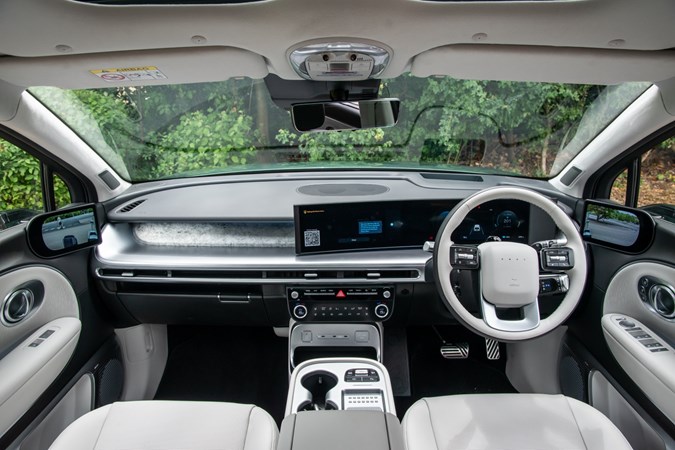
The dashboard itself has a single, wide and curved panel mounted on it that includes both the drivers’ instruments and the central infotainment display. These are both 12.3-inches across.
Welcome menu buttons and climate dials rest below for you to help jump to certain displays, but the system is quite menu-heavy and not the easiest to navigate. Graphics and responses are sharp, though. The top left corner of the infotainment is a bit of a stretch, but the silver strip is at least deep enough to lean your palm on, steadying your inputs.
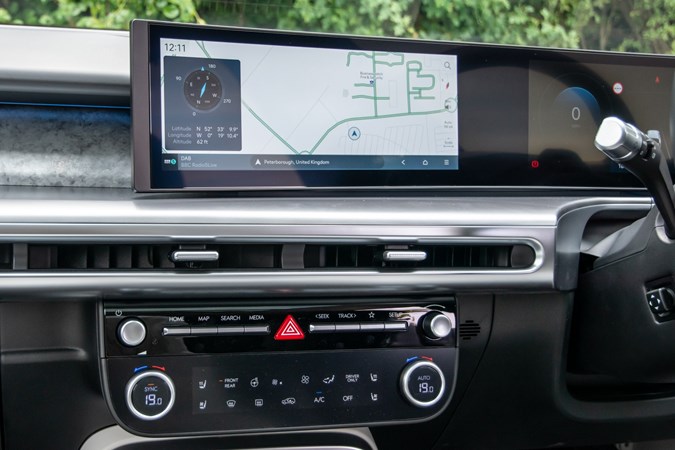
Below the climate controls you have a selection of cubbies and Calligraphy gets a UV light storage area that’s supposedly meant to decontaminate your phone, keys and other pocket residents.
Space is very impressive, allowing even reasonably tall adults to sit in all three rows, assuming second row occupants slide their seats forwards a few inches. Headroom in the front and second row is more than generous, and the third row gets more than a Volvo EX90.
The standard car will feature a seven-seat layout with the second row featuring an adjustable bench seat; optionally available is a six-seat layout that replaces the second row with two full-size chairs.
Huge rear doors make entry and exit easy, and you’ll have no issues loading a child seat or child unless someone has parked close. The second row slides forwards a long way and tilts to allow good access to the third row, or you can just walk between the seats of six seat models.
Comfort
Even in the third row, there’s enough room for adults to handle moderate-length journeys, and everyone inside gets at least one cupholder and a charging port available to them.
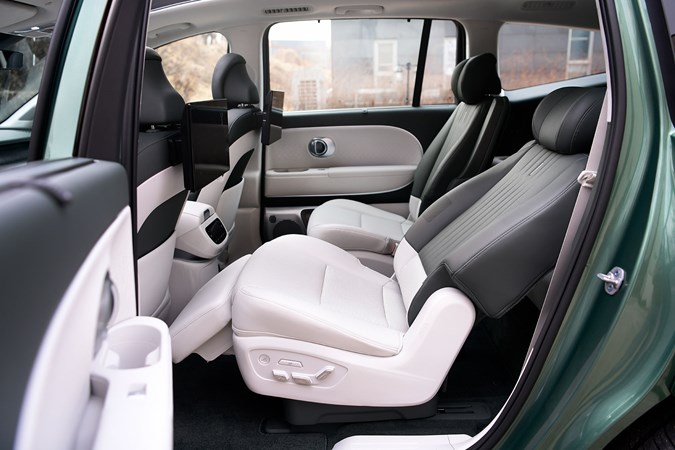
The front four seats of our six-seat Calligraphy spec test car slide and recline, and the fronts even have a pop-out leg support should you want a quick nap whilst charging, for instance. Manually adjustable second row seats were fitted to our UK test car – electric adjustment is available in other markets – that were still able to recline, slide and flip forward easily enough.
We certainly appreciated the ventilated front and second row seats during our hot testing days, and they are also heated for colder weather. They proved comfortable, supportive and offered plenty of adjustment for taller and shorter members of the team. An electrically adjustable steering column was also fitted, which paired to the memory for the seats and mirrors make driver changes easy.
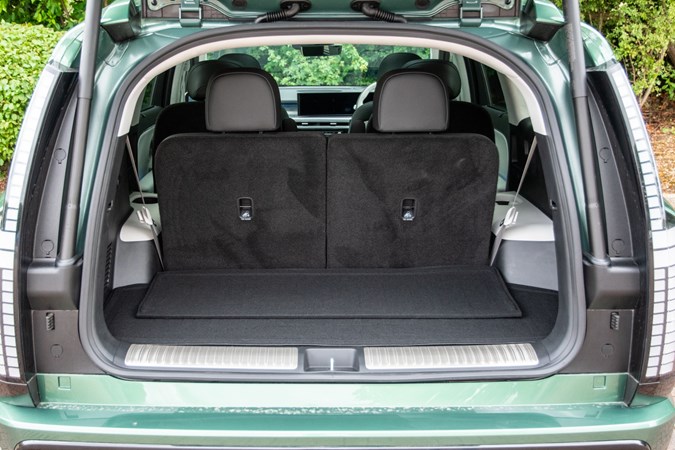
Hyundai Ioniq 9 boot space and practicality
As you’d imagine, boot space is plentiful at 620 litres with all seats up, or 1,323 litres with the third row folded. Just be careful of the softly trimmed third row armrests if you’re planning to carry anything really big. There is a parcel shelf for when you’re in five-seat mode which fits usefully under the boot floor when not in use.
Splitting up the front seats is the new ‘Universal Island’ storage area. As well as some controls for driver aids and modes, this is where you’ll find cupholders, phone storage with wireless charging, drawers at either end as well as a vast central storage area. It also slides fore and aft in six-seat Calligraphy trim, providing you with the ability to make it more accessible for those in the second row.
Usefully, its also double hinged so it can be opened from the front or second row of seats. Second and third row occupants get a pair of cupholders too, so the only real grumble is that the door bins are small for such a big, practical SUV. All six USB-C ports are capable of 100W charging. That’s enough for your laptop, let alone your smartphone, but only if you have the official Hyundai cable.
Electric powertrains
Every Ioniq 9 comes with a 110.3kWh battery pack, making this one of the biggest batteries to be fitted to a production car on sale in the UK and Europe. Three power versions are confirmed for now: Long Range RWD, Long Range AWD and Performance AWD.
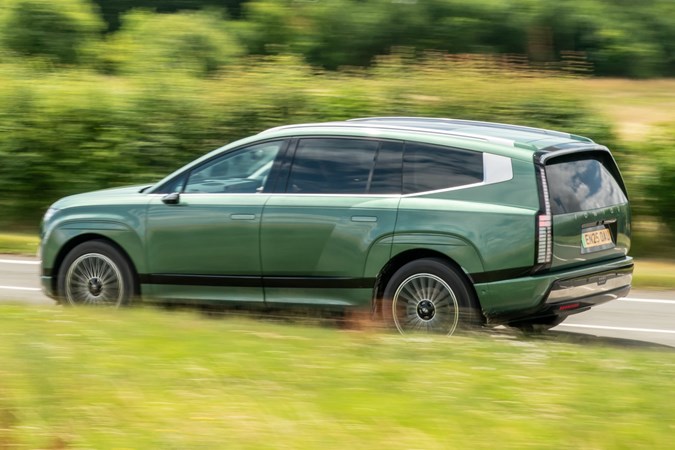
The Long Range RWD is only available with entry-level Premium trim and generates 217hp from a single electric motor for 0-62mph in 9.4 seconds. If you want more pace, you need Ultimate trim for the 313hp Long Range AWD that’ll do 0-62mph in a brisk but not barmy 6.7 seconds. Performance AWD develops 435hp and accelerates from 0-62mph in 5.2 seconds. Amusing, but arguably unnecessary.
Range and charging
Every Ioniq 9 is capable of a massive 350kW charging speed, due to the same technology and platform that underpins many of Hyundai and Kia’s electric cars. That allows for the huge battery to be charged from 10-80% in just 24 minutes on a powerful enough charger. It has 11kW AC charging capability which enables 0-100% in around 11 hours, so expect to add around three hours to that for a typical 7.4kW wallbox.
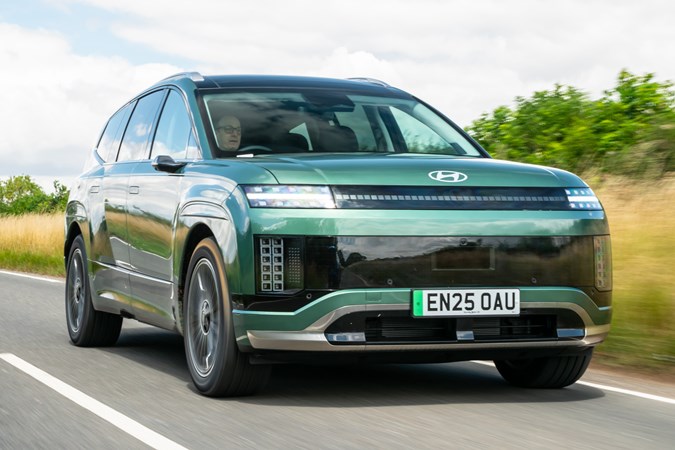
WLTP certified range is certainly competitive. The rear-wheel drive manages up to 385 miles from a single charge, the Long Range AWD 376 and Performance 372 miles.
We spent three warm summer days in the Ioniq 9 Performance and averaged 2.7 miles per kWh on a mixture of dual carriageways, rural roads and some urban work. This would give a calculated range of 297 miles, although the Ioniq 9 claimed it was flat at around 280 miles. Even so, we managed a further eight miles with zero battery showing, so it’s good to know there is a bit of a reserve there.
What’s it like to drive?
We tested a Performance AWD model while in Korea and subsequently in the UK. Despite the name, all versions of the Ioniq 9 are designed to be large and luxurious transportation, so comfort is the focus here.
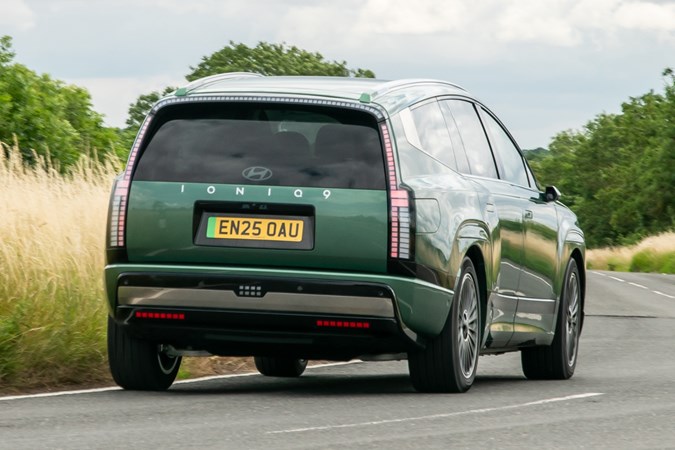
The ride quality does have an edge to it, where it will thud over large bumps and patter over poor surfaces, but it deals with undulations gently. By comparison, a Kia EV9 (particularly in GT Line trim) feels crashy and jittery more of the time when you’re behind the wheel.
We wouldn’t mind if the 9 had a smidge less body roll as it can lean into corners, but this is a tall and heavy car – some concessions will need to be made. It’s also worth pointing out that the 9 doesn’t get air suspension or even adaptive dampers to broaden its capabilities like most rivals.

Get past the lean and you’ll find the Ioniq 9 has lots of grip and well-judged stability control to keep things neat and tidy. You’ll need to wait for an N version – something that hasn’t been ruled out by Hyundai execs – for excitement, though.
The amount of power from this top-spec AWD Performance model is plentiful. Even by EV standards, Hyundai’s nailed the smoothness of power delivery, without any twitchiness from the throttle and a well-defined ramp-up of power as you build speed. We did find ourselves in Sport mode an awful lot to get around a big hesitation when you flattened the throttle, though.
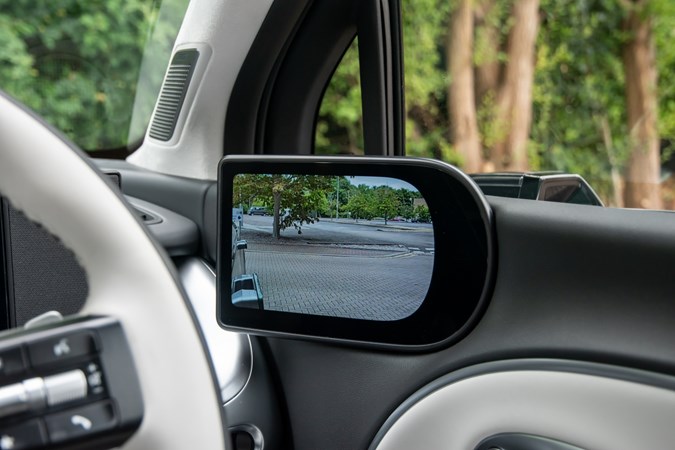
Frankly, this model is a little much, to the point we’d suggest just sticking with the Long Range AWD model instead – it’s still got plenty of power but can potentially achieve an even better range.
It’s a very calm interior with low levels of wind and road noise, and only a gentle whizz from the electric motors. In fact, the most noticeable noise is the suspension thudding away slightly over trickier bumps.
What else should I know?
The entry-level Premium trim is the sensible choice, giving you all the equipment you really need and some luxuries to boot, whilst providing the best driving range of all Ioniq 9s for a fiver under £65k. Our experience with single motor EV9s suggests stepping up to Ultimate trim to get a bit more power (and equipment) is worth it if you can swallow the £9,000 price increase.
Calligraphy certainly paints the Ioniq 9 in its most luxurious light, especially with the six seat option. We’d avoid the Performance model as the power is just unnecessary for this type of car.
Click though to the next page to see a detailed set of ratings for every aspect of the Hyundai Ioniq 9, or read more about how we test cars.




